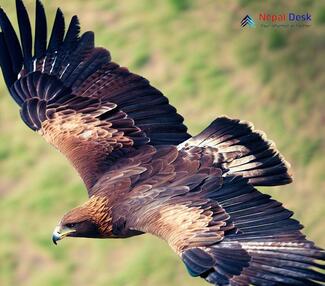Gazing at the magnificent Steppe Eagle (Aquila nipalensis) soaring above the Eurasian steppes, one cannot help but admire its power and elegance. This impressive bird of prey has an extensive range and is often found traversing the mountainous regions of Nepal during its migration. In this article, we'll take you on a captivating journey into the world of the Steppe Eagle, uncovering its distinct attributes, behavior, and significant presence in Nepal.
Exploring the Aquila Nipalensis
This large raptor boasts a wingspan of up to 2.15 meters (7 feet) and a body length between 62 to 81 centimeters (24 to 32 inches). Its dark brown plumage, feathered legs, and formidable beak make it effortlessly identifiable. Mature eagles possess an exceptional patch of lighter feathers on their neck that contributes to their unique appearance.
Steppe Eagles flourish in wide-open spaces like grasslands, semi-deserts, steppes, and even farmlands. Renowned for their agility and strength, these birds masterfully hunt small mammals, reptiles, and other birds by swooping in from above or chasing them down on land.
The Migratory Route: A Bond with Nepal
Although native to Eurasia's vast steppe regions, the Aquila nipalensis migrates to varied areas depending on the season. When winter arrives, some Steppe Eagles journey southward to sub-Saharan Africa and India in pursuit of warmer temperatures and plentiful food sources.
Nepal significantly contributes to these migratory raptors' odysseys by offering temporary respite during their seasonal travels. As they fly through Nepalese skies, Steppe Eagles can be observed in lowland areas, mid-hills, and even lofty mountain valleys like Langtang National Park, Bardia National Park, and Koshi Tappu Wildlife Reserve. Moreover, a few eagles have been known to nest in remote parts of the region.
Protecting the Aquila Nipalensis: Conservation Initiatives
The IUCN Red List of Threatened Species currently classifies the Steppe Eagle as "Endangered" due to numerous threats, including habitat loss, electrocution from power lines, chemical poisonings from agricultural practices, and diminished food sources. Consequently, their population has seen significant declines in recent years.
Conservation organizations in Nepal work tirelessly to ensure Aquila nipalensis's survival and well-being by conducting regular monitoring and research to obtain crucial data on population trends and breeding success. Armed with this knowledge, experts can design effective strategies to safeguard the Steppe Eagle and its natural environment throughout Nepal while raising global awareness of their plight.
In summary, the awe-inspiring Steppe Eagle (Aquila nipalensis) symbolizes grace and power for those lucky enough to witness its majestic flight across the Nepalese skies. Through persistent conservation efforts and public awareness campaigns, we can guarantee that future generations will continue to marvel at this extraordinary raptor for years to come.




